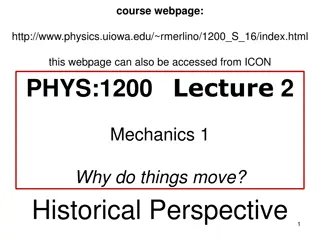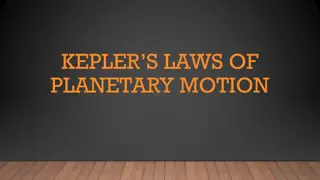Understanding Orbital Dynamics: From Newton's Laws to Kepler's Laws
Exploring the fascinating realm of orbital dynamics, this content delves into the application of Newton's laws to explain Kepler's laws and the intricacies of orbital mechanics. Deriving Kepler's laws from Newton's law of gravitation involves advanced mathematics, while also emphasizing the significance of angular momentum and orbital energetics in determining orbits. The concept of energy conservation, angular momentum, and the application of Kepler's third law are discussed, providing a deeper insight into celestial motion.
Download Presentation

Please find below an Image/Link to download the presentation.
The content on the website is provided AS IS for your information and personal use only. It may not be sold, licensed, or shared on other websites without obtaining consent from the author. Download presentation by click this link. If you encounter any issues during the download, it is possible that the publisher has removed the file from their server.
E N D
Presentation Transcript
ASTR 2310 General Astronomy I Professor Mike Brotherton Ryden & Peterson Chapter 3: Orbital Mechanics Newton's Laws of Motion & Gravitation; (Derivation of Kepler's Laws); Conic Sections and other details; General Form of Kepler's 3rd Law; Orbital Energy & Speed; Virial Theorem
Orbital Dynamics Newton theory to explain Kepler s laws and to go beyond Issue of sign on Law of Gravitation Circular orbits not too hard with this information, I hope? Let s write that down and discuss.
Orbital Dynamics Deriving Kepler s Laws from Newton s law of Gravitation and Laws of Motion requires vector calculus and mathematics beyond the prerequisites of the class. If you have the math, please do take the opportunity to read carefully section 3.1 in Ryden and Peterson. There s a bunch of useful stuff in there about ellipses, too, for instance (e.g., e=(1-b2/a2)1/2). Alternative calculus-based derivations of Kepler s laws and related equations can be found here: https://faculty.fiu.edu/~vanhamme/ast3213/orbits.pdf
Orbital Dynamics Some applications of Kepler s third law: mass What about mass of the sun?
Orbital Dynamics Some applications of Kepler s third law: mass What about mass of the sun?
Angular momentum L L Concept of Angular Momentum, L Linear version: L = rmv Vector version: L is the cross product of r and p Angular momentum is a conserved quantity
Orbital Energetics Energy determines if an orbit is closed (circle or ellipse) or open (parabola or hyperbola). As in harmonic motion, energy is conserved and shifts between kinetic and potential: More vector math we ll skip in class, but you can read in text.
Orbital Energetics Hyperbolic orbits: e > 1, E > 0, and K > |U| Parabolic orbits: e=1, E = 0, K = |U| Elliptical orbits: e < 1, E < 0, K < |U|
Orbital Speed No simple equations for r( t ) or v( t ), but there is for v( r ), called the vis viva equation: This is derived in the text for those interested, based on tracking kinetic energy with radius. We will mostly worry about its application in this course.
Orbital Speed Other versions of the vis viva equation from substitions and change of variables:
Orbital Dynamics Example problem in textbook:
Orbital Dynamics Example problem in textbook:
Hohmann transfer orbit (to) Ryden & Peterson shows case for Earth to Mars. Need semi-major axis of to Then what is orbital period of to? Time to Mars? Speed of Earth? Speed of Mars? Use vis viva equation at both ends to calculate the delta vees. Use care to determine launch windows.
Hohmann transfer orbit (to) Ryden & Peterson shows case for Earth to Mars. Need semi-major axis of to
Hohmann transfer orbit (to) Ryden & Peterson shows case for Earth to Mars. Need semi-major axis of to Then what is orbital period of to?
Hohmann transfer orbit (to) Ryden & Peterson shows case for Earth to Mars. Need semi-major axis of to Then what is orbital period of to? Time to Mars? HALF the to orbital period, right?
Hohmann transfer orbit (to) Ryden & Peterson shows case for Earth to Mars. Need semi-major axis of to Then what is orbital period of to? Time to Mars? Speed of Earth?
Hohmann transfer orbit (to) Ryden & Peterson shows case for Earth to Mars. Need semi-major axis of to Then what is orbital period of to? Time to Mars? Speed of Earth? Speed of Mars?
Hohmann transfer orbit (to) Ryden & Peterson shows case for Earth to Mars. Need semi-major axis of to Then what is orbital period of to? Time to Mars? Speed of Earth? Speed of Mars? Use vis viva equation at both ends to calculate the delta vees.
Hohmann transfer orbit (to) Ryden & Peterson shows case for Earth to Mars. Need semi-major axis of to Then what is orbital period of to? Time to Mars? Speed of Earth? Speed of Mars? Use vis viva equation at both ends to calculate the delta vees.
Got it? 60 second check https://ifunny.co/video/0wRlnem09
Orbital Dynamics Virial Theorem (needs vector calculus to derive, in previous link of derivations) For gravitational systems in equilibrium: K= - U Will be handy in many astronomical situations, not just orbits in the solar system. Very general, works for systems of objects (e.g., star clusters, galaxy clusters).
Orbital Mechanics Resource Old style but nice webpage: http://www.braeunig.us/space/orbmech.htm























